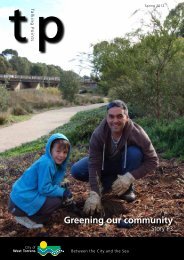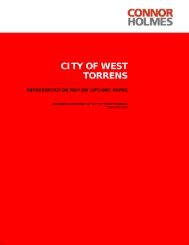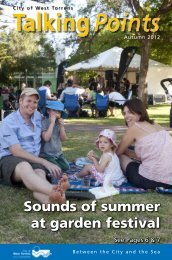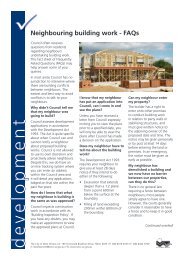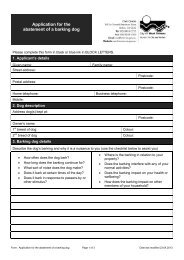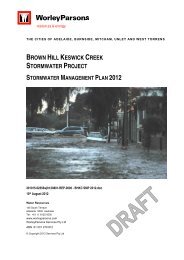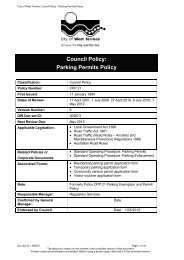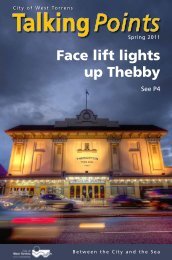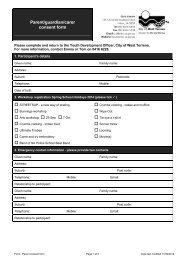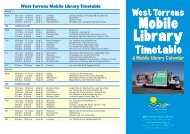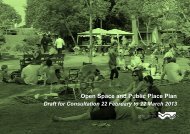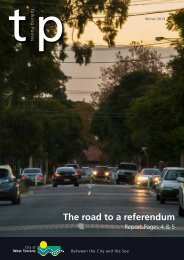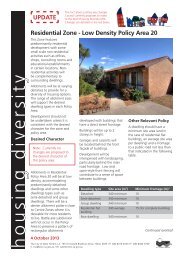Recommendations - City of West Torrens - SA.Gov.au
Recommendations - City of West Torrens - SA.Gov.au
Recommendations - City of West Torrens - SA.Gov.au
You also want an ePaper? Increase the reach of your titles
YUMPU automatically turns print PDFs into web optimized ePapers that Google loves.
Setting objectives for LATM allows a<br />
scheme to be assessed, implemented<br />
and measured against the desired<br />
outcomes.<br />
A possible approach to setting<br />
objectives is as follows:<br />
Primary objectives:<br />
• improve the safety <strong>of</strong> the street<br />
network<br />
• reduce the environmental impact <strong>of</strong><br />
traffic.<br />
Specific objectives:<br />
• reduce speed<br />
• reduce volumes<br />
• reduce through traffic<br />
• reduce heavy vehicles.<br />
Secondary objectives:<br />
• maintain access through the <strong>City</strong> for<br />
residents<br />
• avoid transferring traffic from one<br />
street to another.<br />
In practice, the above approach has<br />
been used by the <strong>City</strong> <strong>of</strong> <strong>West</strong> <strong>Torrens</strong><br />
over many years <strong>of</strong> LATM studies and<br />
traffic management.<br />
Recommendation<br />
• Adopt the above objectives for<br />
LATM studies.<br />
2.1 The need for and the<br />
process for a LATM study<br />
The need usually arises from:<br />
• resident concerns about traffic<br />
conditions in an area<br />
• known through traffic issues and<br />
increasing impact on the local area<br />
• need to reduce traffic-related<br />
problems on an area-wide basis<br />
• traffic concerns arising from major<br />
new developments or new road<br />
projects in or abutting the area<br />
• proactive approach to road safety in<br />
the local area.<br />
While a LATM is intended to provide<br />
positive traffic outcomes to a local<br />
area, there are negative effects that<br />
would result, including:<br />
• increased travel time for drivers<br />
• increase in noise adjacent to devices<br />
• impact on on-street parking<br />
• impact on cyclists and pedestrians<br />
• restricted access to properties<br />
• effect on emergency service vehicles<br />
• transfer <strong>of</strong> traffic from one street<br />
to another<br />
• enforcement issues and difficulties<br />
• costs to Council.<br />
A LATM study area is usually bounded<br />
by arterial roads, other physical<br />
barriers such as creeks, railways or<br />
reserves, and in the case <strong>of</strong> the <strong>City</strong><br />
<strong>of</strong> <strong>West</strong> <strong>Torrens</strong>, the Adelaide Airport<br />
boundaries.<br />
The process involved in a LATM study<br />
is generally as follows:<br />
• prepare LATM study<br />
• define the objectives<br />
• develop options and plan for the<br />
LATM<br />
• design the approved LATM scheme<br />
• implement the LATM scheme<br />
• monitor and review.<br />
The <strong>City</strong> <strong>of</strong> <strong>West</strong> <strong>Torrens</strong> has undertaken<br />
many such LATM studies in past years.<br />
The above summary provides the<br />
background and the methodology<br />
previously used in the <strong>City</strong> and such<br />
a process is recommended to be<br />
retained.<br />
2.2 The need for a warrantbased<br />
priority system for LATM<br />
studies<br />
The Austroads Guide to Traffic<br />
Engineering Practice Part 10 lists three<br />
possible warrant system to determine<br />
priority for LATM decision making, ie:<br />
• “Qualifying conditions” to merit<br />
closer examination.<br />
• Warrants expressed as acceptable<br />
thresholds <strong>of</strong> stated criteria.<br />
• Warrants, usually expressed as<br />
points, to provide a basis for<br />
priority ranking.<br />
The simplest approaches to indicators<br />
<strong>of</strong> the need for action comes in the<br />
form <strong>of</strong> a “checklist” or sieve <strong>of</strong><br />
conditions, some <strong>of</strong> which may be<br />
qualitative, that must apply in order for<br />
a street to qualify for closer inspection.<br />
This approach is compatible with a<br />
one-<strong>of</strong>f, street-bystreet approach to<br />
traffic calming but is also useable in<br />
area-wide LATM.<br />
Source: Austroads<br />
This has been the approach <strong>of</strong> the <strong>City</strong><br />
<strong>of</strong> <strong>West</strong> <strong>Torrens</strong> for many years. The<br />
“sieving” <strong>of</strong> conditions include:<br />
• assessment <strong>of</strong> the current street<br />
conditions<br />
• review <strong>of</strong> the traffic volumes, speeds<br />
and commercial traffic<br />
• review <strong>of</strong> through traffic usage<br />
• analysis <strong>of</strong> the crash data<br />
• adjacent land uses<br />
• road hierarchy.<br />
70<br />
Part 2 - Traffic Management | Objectives and Setting Criteria



